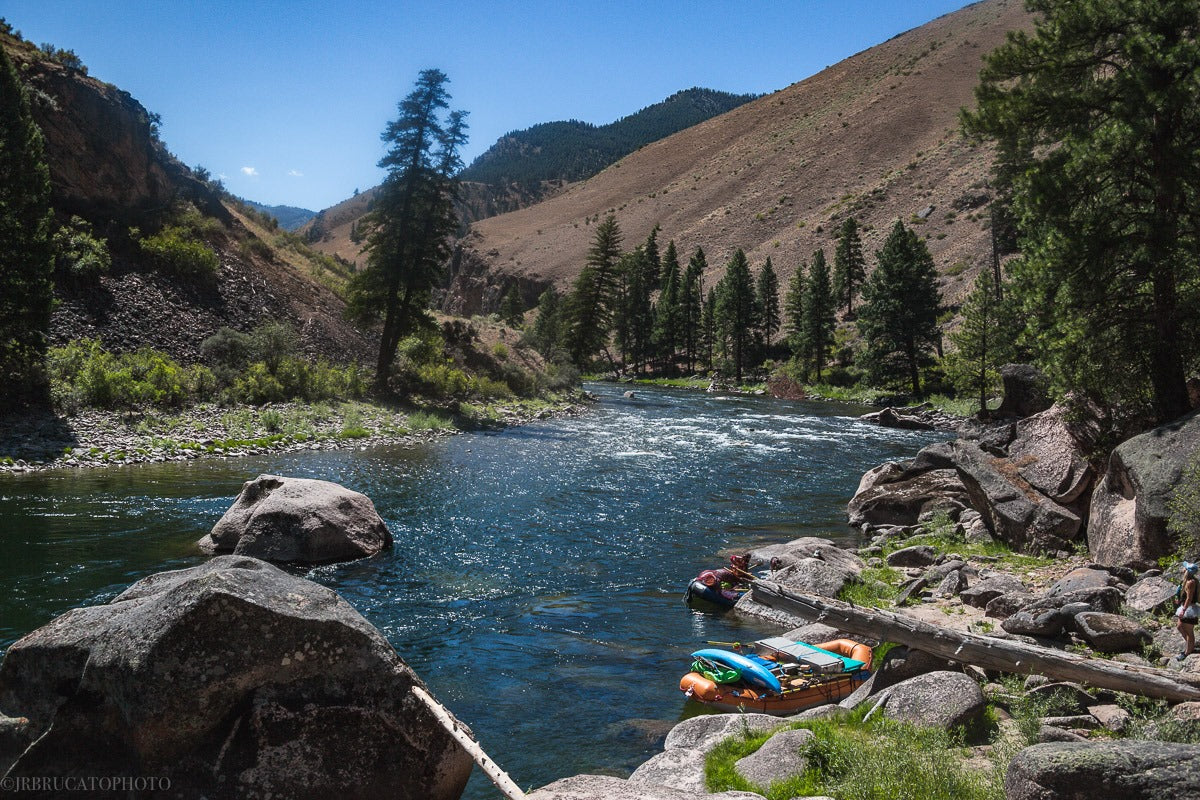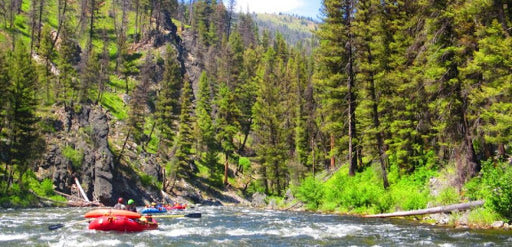
Adventure Report: No Return Wilderness
I get the call from my friend Jeff: “You want to run the Middle Fork again?”
The Middle Fork is a 104 mile free-flowing Class IV river in the Frank Church River of No Return Wilderness. The Middle Fork originates 20 miles northwest of Stanley, Idaho, at the confluence of Bear Valley and Marsh Creeks.
Last year I stand up paddle boarded the Middle Fork of the Salmon at 3.5 feet, and it was the largest thing I had ever done. This year, there were rumors that it was going to peak at maybe 6 feet or more. I was nervous but excited to try to SUP the whole thing again.
Having a solid board for this stretch is extremely important if I wanted to make it through these rapids successfully and safely. The Hala Atcha was my board of choice for its perfect combination of volume and width providing stability in big water and agility to make the lines I needed.
The permit was maxed out with a crew of 24 amazing people: 7 rafts, 3 kayakers, and a spare paddle board if anyone wanted to try it out. We get to the put in and I was a little relieved to find the river at 5.5 feet, which is a bit more friendly than 6 feet, but still big.

The first day was full on. We paddled 21 miles to our first camp. Five miles in and it was so difficult to catch eddies to catch my breath and rest.
The first big rapid we got to was a class IV named Velvet Falls. We all got out and scouted. I was confident that I could catch the eddy on the river left above the falls and try to film the rafts. So I paddled ahead on my own. Entering the rapid I noticed it was really pushy. I charged hard as I could for the eddy but got rejected.
The eddy was full of boils and it pushed me back into the main current. I looked downstream to find my line and set up to run the left side of the falls, plugging my nose before making the plunge. After a big swim, I got on my board and paddled to shore to set up and film the rafts. For the rest of the day I only managed 2 more swims!
Waking up the next morning I knew it was going to be another big day paddling. We were going to try to cover about 30 miles that day and only a few miles into it we hit Pistol Rapid, another big class IV. This rapid was one worth scouting, and when looking at it from above, the line seemed obvious - catch the big eddy on the right and you avoid left at all costs.

I get into the rapid and my plan went south as soon as I realized that big eddy on the right wasn’t the friendly eddy it had appeared to be. In its place was a turbulent boiling eddy wall. I paddled as hard as I could into the mess that I thought would be my “safe line” but I was no match for those powerful boils and I was quickly knocked off my board. I got one good breath in before I went into the left side of the hole. Everything was bubbles of brown water and then darkness.
Below the surface, I started counting to keep myself calm. I got to about 10 before I saw daylight and swam for it. I came up to cheers from the rafts. “You went deep!” my friend Shawn called. Drained by the adrenaline, I was relieved the rest of the day was free of boiling eddies and munchy holes. I was able to convince my friend Shawn to hop on a paddle board and try it out. She paddled through a few fun rapids and was surprised by the stability of the Hala Atcha.
Day 3 was a mellow two-mile paddle to our next camp. Christie wanted to give paddleboarding a shot so I inflated the second board and took her down the river for the first time. After the events of the day before we were all happy to have a day of care-free paddling.

From camp, Greg and I were looking for a little more excitement so we took the paddle boards and hiked up to a fun class III section on Loon Creek. The rest of the day was spent soaking in hot springs, dancing around in costumes, and playing croquet.
The last two days were filled with some really fun big water. I put a 9” fin on my Hala Atcha so I could maintain my line and power through the massive waves. I learned that the toughest part about large volume rapids is the aggressive eddy lines and unpredictable boils. It’s an added challenge that I’m not used to on a SUP and in turn, has improved my paddling skills immensely.
The Atcha, not letting me down, helped me get everywhere I needed to be and the added rigidity from the drop stitching in the board made it easy for me to react to any bumps or waves and remain stable on my feet.
This trip was amazing, of one of my top five stretches of river and I would recommend it for any experienced whitewater stand up paddler!
Nadia Almuti is a team rider and social media manager for Hala Gear.




Leave a comment
This site is protected by hCaptcha and the hCaptcha Privacy Policy and Terms of Service apply.